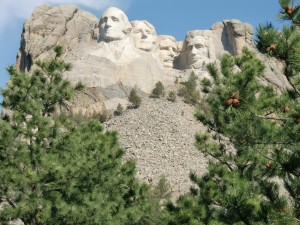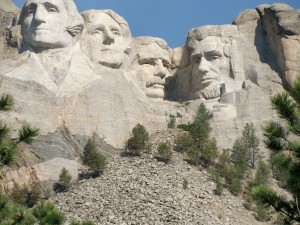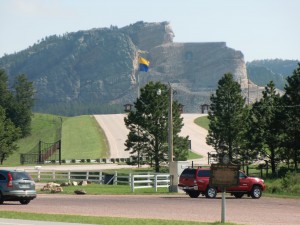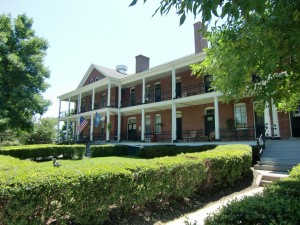THE BEST OF THE WEST-DIPPING INTO NEBRASKA
THE BEST OF THE WEST
This is the tenth in a series of articles about traveling the west by bus
DIPPING INTO NEBRASKA
By Charles N. Stevens
Photos by Dolores Seidman
On a fresh morning, the wind rippling the flags at our motel, we head back to Mount Rushmore for one last look. We had seen the presidents’ faces only in dim light yesterday, but today is bright and sunny. We look at them now in full sunlight with sharp shadows, those great white stony faces looking out into the clear mountain air. We again marvel at the remarkable monument, noting that president Theodore Roosevelt rested in shadow while the others captured the sun.
Dolores and I step down into the original viewing area where we have it all to ourselves. We listen to the wind in the pines and gaze out at the sculptures as though we own them. Low scattered clouds race over the mountains, hiding the higher peaks.
On our way again, we pause by the side of the road to view, at a distance, the ongoing work of the Crazy Horse Memorial being sculpted out of the side of a bluff. Begun by Korczak Ziolkowski and Lakota Chief Standing Bear, it will celebrate the rich heritage of the American Indian. The face of Crazy Horse was dedicated in 1948, but his extended arm and his horse are still being fashioned. The area is five miles from Custer, South Dakota and near the site of Custer’s last battle at Little Big Horn.
We pass through green valleys with pine ridges on both sides, the landscape gradually opening up into rolling grassy fields sprinkled with magenta wild flowers. Now and then we come upon antelope grazing near the road as well as enclosed buffalo herds. Prairie dogs pop out of their holes, peering at us in their curious way. Cattlemen, we are told, do not like the prairie dog villages as cattle stepping in their holes can break a leg.
Later we roll through the small town of Hot Springs, South Dakota and its main street of over thirty classical sandstone buildings. The natural hot springs here were frequented by the Sioux and Cheyenne Indians and were a point of contention when Europeans wanted to use them also. Today there are several spas and pools fed with the natural hot water and are the area’s main attraction. The town also includes The Mammoth Site, a collection of mammoth and other ice age mammal bones. Apparently the animals had fallen into a large sinkhole where the bones were found. It is frustrating not to be able to visit it.
Moving on, we pass open range with hay fields, cylindrical bales looking like great cinnamon rolls on their sides scattered over the land. There is so much wide open space out here where we can see great distances. It tends to draw out our vision, a relief to us who continually move about in confined spaces.
Soon we speed by a sign reading “Nebraska, The Good Life.” Cattle graze in the green prairie and the rolling hills, more grass available than a herd of cows could possibly eat. Farm or ranch houses are scattered far and wide, causing me to think about how solitary their lives must be, especially compared to us who all live in cities. We stop at a WalMart in Chadron, Nebraska where we pick up items for lunch. Nearby buttes rise up out of the prairie.
In early afternoon we arrive at old Fort Robinson, a large area of barracks and stables as well as a vast parade ground. Many cottonwood trees line its avenues, all of them shedding fluff that drifts in the wind and falls to the ground. The stables smell like horses, and a large fan stirs the air to cool them on the hot afternoon. The fort has a long history dating back to 1876 when the American flag was raised over the establishment. It was primarily established to deal with the Indians in the area, many of them being imprisoned there. It was here in 1877 that Crazy Horse was killed when he tried to escape the fort. It was later used to train cavalry and during World War II served as a prison camp for German soldiers.
Today Fort Robinson is a state park, the old barracks being converted into cabins where tourists can stay. Recreation includes horseback riding, fishing and hiking on the 22,000 acres now comprising the park. Dolores and I walk into the main barracks established in 1909, a two-story, white-fronted building with tall white columns in front. Today it is a lodge and restaurant, far different from what its function used to be.
Clouds had been building all day, and by the time we reach our first rest stop raindrops polka dot the sidewalks. During the bus stop, I walk around to stretch my legs, noting the abundance of tall prairie grasses. There is a beauty about them that I had never realized before and found myself wanting to know more about them. As we move on a lightning bolt zaps to the ground not far away.
We reach Cheyenne, Wyoming about dinner time, first passing over a bridge that spans the gigantic Union Pacific freight yards and the old station, now no longer used. It had been a busy day, and after a tempted-to-over-eat meal at the Country Buffet, we settle down in the Holiday Inn for a good night’s rest.

From the original viewing area, Dolores and I have the presidents all to ourselves.

From this spot the details for the presidents' features are amazingly clear.

If you look carefully at the top of this photo, you can see Crazy Horse peering out over the prairie.

We stepped inside Ft. Robinson's 1909 Barracks, now a hotel and restaurant.
MONTEREY PARK AUTHOR PUBLISHES 3RD BOOK ABOUT HIS EXPERIENCES IN WORLD WAR II- BACK FROM COMBAT
Charles “Norm” Stevens, a 40 year resident of Monterey Park and World War II Veteran has recently published the 3rd in his series about his experiences in WW II, Back from Combat: A WWII Bombardier Faces His Military Future. This book details the time from when he returned from combat in England where he flew 34 missions over Germany and France until the end of the war. Faced with large numbers of returning combat vets, and not knowing how long the war would continue, the military had to plan for their future. His options were whether to return to combat, become an instructor in the U.S., or receive new training that he would use in the Pacific. The book concludes with the end of the war with an Afterward that includes an update on the B-l7’s still flying in the U.S., as well as present day accounts pertaining to the war.
Stevens is the author of two previous books about his experiences:
An Innocent at Polebrook: A Memoir of an 8th Air Force Bombardier (Story of his 34 bombing missions from his base at Polebrook, England over Germany and France)
The Innocent Cadet: Becoming A World War II Bombardier (A prequel to the first, telling of his training in the U.S. before going overseas into combat.)
He is known to the readers of The Citizen’s Voice as the author of Travel Log Articles including “From Paris to Normandy on the Seine”, “Exploring New York” and “In Search of Snow.” He is retired, having taught for 32 years, primarily in the Montebello Unified School District.
Those interested in purchasing an autographed copy of any of his books, may contact the author at 323-721-8230 or Normstevens24@gmail.com.



